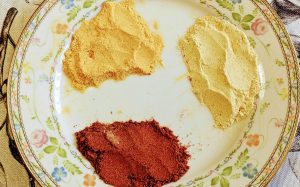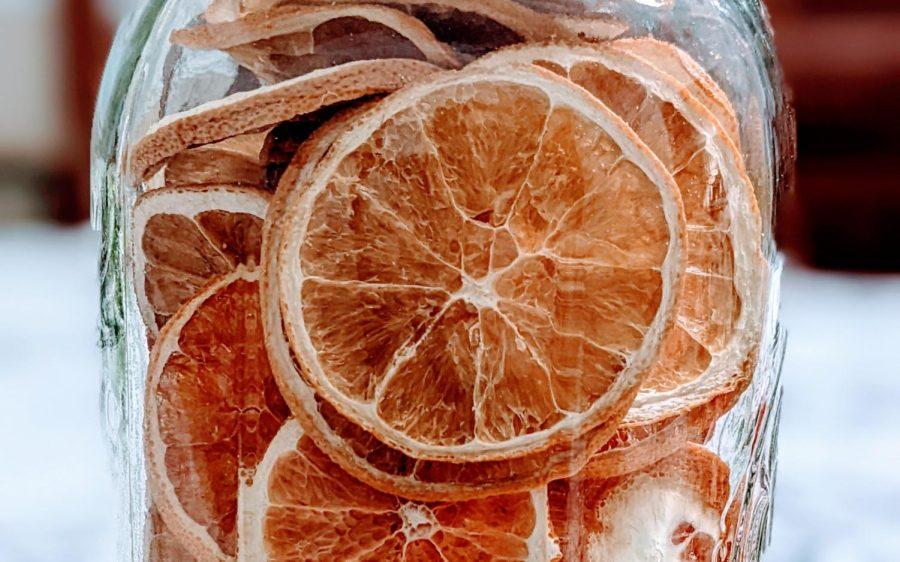Preserved Home: Citrus can offer daily dose of recipe options
Dehydrating citrus can be a favorite way to preserve the fruit, and it can be used daily in a variety of uses. (Photo by Laura Woolfrey Macklem)
February 4, 2022
I grew up in Escondido, and my best friend growing up was Veronica. Her family was like my own, and I spent many days out in their back yard, which was filled with 32 orange trees, dripping with fruit. I remember picking warm oranges from Veronica’s trees, and eating them on the spot. Her mom would send me home with paper bags busting with fragrant oranges. There is nothing like California citrus — Florida can’t even begin to touch it.
My parents now live in Menifee, and they too have a bounty of citrus, particularly lemons. My mother is always lamenting how many lemons are drooping from the branches, and how she doesn’t know how to employ them all. Being overwhelmed with fresh citrus is a burden I personally would welcome. There are so many creative ways to use an abundance of citrus and preserve its goodness all year long.
 I don’t live near a citrus grove anymore, but when I find a sale, I take full advantage. I’ve done a couple things that haven’t quite worked, however. I tried to juice and can orange juice but the canning process makes it bitter. I also tried to steam-juice oranges to extract juice that way, but the result is more like orange water. I was left with pulp, which I used to make marmalade. Next time oranges go on sale, I’ll try orangeade, because my limeade and lemonade concentrate turned out beautifully.
I don’t live near a citrus grove anymore, but when I find a sale, I take full advantage. I’ve done a couple things that haven’t quite worked, however. I tried to juice and can orange juice but the canning process makes it bitter. I also tried to steam-juice oranges to extract juice that way, but the result is more like orange water. I was left with pulp, which I used to make marmalade. Next time oranges go on sale, I’ll try orangeade, because my limeade and lemonade concentrate turned out beautifully.
The lemonade and limeade concentrate have been a fun addition to my pantry. There’s nothing artificial in my jars, and 1 pint of concentrate mixed with 3 pints of cold water makes a refreshing half gallon of freshly squeezed lemon or limeade. Sure, you can still make it without canning, but who always has the time to make freshly squeezed juice? No more of the sludgy cans of frozen fake stuff when the real deal is on your shelf.
Canning citrus drink mixes is only one way to get the good stuff in jars — you can also can the whole fruit. My family has never liked store-bought canned fruit because the flavor is masked by a sickening sweet, thick syrup. Canning fruit at home can be done in water, but a little sugar preserves the quality, which is why I choose an extra-light sugar solution. I have only canned orange and grapefruit sections, but it might be fun to can lemon sections as an experiment. Another option is to can grapefruit and oranges together in the same jar, and even add spices if you desire.
While lemons can be preserved in jars, they are also a unique kitchen condiment when fermented. Preserved lemons are sliced in quarters, but not all the way through, and packed with salt, soaked in water with aromatics of your choice. After fermentation is done, they are stored in refrigeration for up to six months. Preserved lemons are good in salad dressings, with sautéed meats, grilled fish, and any other dish you choose to gussy up with this salty, sour and zesty ingredient.

Dehydrating citrus is probably my favorite way to preserve the fruit, and I use mine daily. I put dehydrated citrus slices in my water, and iced tea. I break the rounds into little pieces and tuck them into tea bags. You can stuff them in chicken, eat them as a snack, which is especially good when the orange rounds are dipped in chocolate. I use dehydrated lemons and oranges when making hot apple cider.
Give your chicken soup a brightness by adding a dehydrated lemon slice to the pot. I also use lemons to make “lemonade wheels,” which are lemon slices rolled in sugar and dehydrated. Put two in a glass, let sit 30 minutes and you have lemonade.
You can also partially dehydrate bits of orange to create that pop of juice in the middle, like I used to love with Juicy Fruit gum. Cut peeled orange sections into chunks and dehydrate at 135 for about 6 hours, until the outside is no longer sticky. The juice should still be in the middle for a fresh, non-messy snack. These must be refrigerated, however, as they aren’t fully dry.
The excitement doesn’t end there with dehydrated citrus — you can also make citrus powder.
I pulverize my dehydrated citrus into powder after dehydrating the wheels until they are extra crisp. Sometimes I cut the rind off before dehydrating, and sometimes I don’t. Fruit powders in general are an exciting addition to your pantry, and my collection includes blueberry, raspberry, pineapple, cranberry lemon, lime, orange and apple powders. They can be added to frostings, batters, ice cream, whipped cream, dry rubs and mixes, teas, smoothies, and to make fruit sugars. I’m working on a guacamole dry seasoning mix using some of my lime powder.
Flavored salts are a perfect way to use citrus powders. I recently made an orange thyme salt and am exploring homemade lemon pepper. Before storing your powders, there must be no moisture to avoid caking. After powdering your fruit, lay out on a parchment-paper-lined baking sheet for a couple of days as insurance that the moisture won’t be an issue.
I remember driving from Escondido to Moonlight Beach in Encinitas as a teenager, passing produce stands overflowing with fresh blood oranges and other fruits and vegetables. Before I knew about preserving, I would stop along the road just buy a little here and there, and savor the produce fresh. I may not have preserved fruit back then, but what I have preserved are memories growing up surrounded by citrus and avocado groves, friendly produce vendors, and, most of all, a very best friend named Veronica who I played with in that little orange grove in her back yard so many years ago.
Lemonade Concentrate for Canning
Yields 7 Pints
6 cups of fresh squeezed lemon juice
6 cups of water
6 cups of sugar
Bring all ingredients to a gentle boil.
As soon as the mixture reaches a boiling point, fill 7 pint jars, leaving 1/4 inch head space. Wipe rims clean. Secure with rings and lids, and water bath can for 15 minutes. To reconstitute, add about 3 to 3 1/2 pints per pint of concentrate.
For more recipes, tips and details, visit Laura Woolfrey Macklem’s Preserved Home blog at www.preservedhome.com.
Columns represent the views of the individual writer and do not necessarily reflect those of the North Coast Current’s ownership or management.
encinitas current, cardiff current





